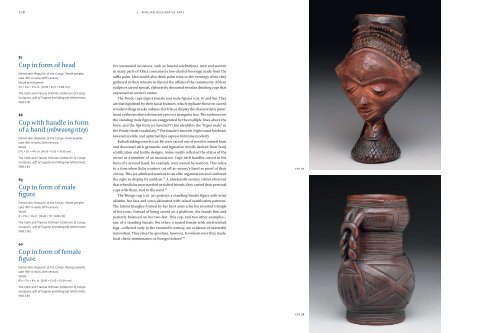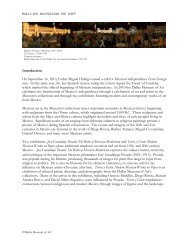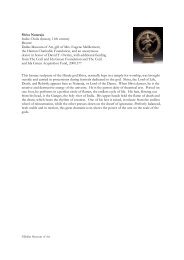the arts of africa - Dallas Museum of Art
the arts of africa - Dallas Museum of Art
the arts of africa - Dallas Museum of Art
You also want an ePaper? Increase the reach of your titles
YUMPU automatically turns print PDFs into web optimized ePapers that Google loves.
238 3 : <strong>africa</strong>n decorative <strong>arts</strong><br />
87<br />
Cup in form <strong>of</strong> head<br />
Democratic Republic <strong>of</strong> <strong>the</strong> Congo, Pende peoples<br />
Late 19th or early 20th century<br />
Wood and pigment<br />
57/* × 37/! 6 × 313/! 6 in. (14.92 × 8.73 × 9.68 cm)<br />
The Clark and Frances Stillman Collection <strong>of</strong> Congo<br />
Sculpture, gift <strong>of</strong> Eugene and Margaret McDermott,<br />
1969.S.161<br />
88<br />
Cup with handle in form<br />
<strong>of</strong> a hand (mbwoong ntey)<br />
Democratic Republic <strong>of</strong> <strong>the</strong> Congo, Kuba peoples<br />
Late 19th or early 20th century<br />
Wood<br />
513/!<br />
6<br />
× 3¾ × 45/!<br />
6<br />
in. (14.76 × 9.53 × 10.95 cm)<br />
The Clark and Frances Stillman Collection <strong>of</strong> Congo<br />
Sculpture, gift <strong>of</strong> Eugene and Margaret McDermott,<br />
1969.S.44<br />
89<br />
Cup in form <strong>of</strong> male<br />
figure<br />
Democratic Republic <strong>of</strong> <strong>the</strong> Congo, Pende peoples<br />
Late 19th or early 20th century<br />
Wood<br />
6 × 315/!<br />
6<br />
× 37/* in. (15.24 × 10 × 9.84 cm)<br />
The Clark and Frances Stillman Collection <strong>of</strong> Congo<br />
Sculpture, gift <strong>of</strong> Eugene and Margaret McDermott,<br />
1969.S.162<br />
90<br />
Cup in form <strong>of</strong> female<br />
figure<br />
Democratic Republic <strong>of</strong> <strong>the</strong> Congo, Wongo peoples<br />
Late 19th or early 20th century<br />
Wood<br />
87/!<br />
6<br />
× 53/* × 43/!<br />
6<br />
in. (21.43 × 13.65 × 10.64 cm)<br />
The Clark and Frances Stillman Collection <strong>of</strong> Congo<br />
Sculpture, gift <strong>of</strong> Eugene and Margaret McDermott,<br />
1969.S.49<br />
On ceremonial occasions, such as funeral celebrations, men and women<br />
in many p<strong>arts</strong> <strong>of</strong> Africa consumed a low-alcohol beverage made from <strong>the</strong><br />
raffia palm. Men would also drink palm wine in <strong>the</strong> evenings when <strong>the</strong>y<br />
ga<strong>the</strong>red in <strong>the</strong>ir retreats to discuss <strong>the</strong> affairs <strong>of</strong> <strong>the</strong> community. African<br />
sculptors carved special, elaborately decorated wooden drinking cups that<br />
expressed an owner’s status.<br />
The Pende cups depict female and male figures (cat. 87 and 89). They<br />
are distinguished by <strong>the</strong>ir facial features, which replicate those on carved<br />
wooden village masks (mbuyu). Both faces display <strong>the</strong> characteristic prominent<br />
eyebrows above downcast eyes in a triangular face. The eyebrows on<br />
<strong>the</strong> standing male figure are exaggerated by <strong>the</strong> multiple lines above <strong>the</strong><br />
brow, and <strong>the</strong> lips form an inverted V that identifies <strong>the</strong> “hyper male” in<br />
<strong>the</strong> Pende visual vocabulary.30 The female’s smooth, high round forehead,<br />
lowered eyelids, and upturned lips express feminine modesty.<br />
Kuba drinking vessels (cat. 88) were carved out <strong>of</strong> wood or animal horn<br />
and decorated with geometric and figurative motifs derived from body<br />
scarification and textile designs. Some motifs reflected <strong>the</strong> status <strong>of</strong> <strong>the</strong><br />
owner as a member <strong>of</strong> an association. Cups with handles carved in <strong>the</strong><br />
form <strong>of</strong> a severed hand, for example, were owned by warriors. This refers<br />
to a time when Kuba warriors cut <strong>of</strong>f an enemy’s hand as pro<strong>of</strong> <strong>of</strong> <strong>the</strong>ir<br />
victory. This act admitted warriors to an elite organization and conferred<br />
<strong>the</strong> right to display its emblem.31 A nineteenth-century visitor observed<br />
that when Kuba men traveled or visited friends, <strong>the</strong>y carried <strong>the</strong>ir personal<br />
cups with <strong>the</strong>m, tied to <strong>the</strong> waist.32<br />
The Wongo cup (cat. 90) portrays a standing female figure with arms<br />
akimbo, her face and torso decorated with raised scarification patterns.<br />
The lateral triangles formed by her bent arms echo <strong>the</strong> inverted triangle<br />
<strong>of</strong> her torso. Instead <strong>of</strong> being carved on a platform, she stands firm and<br />
perfectly balanced on her two feet. This cup, and two o<strong>the</strong>r examples—<br />
one <strong>of</strong> a standing female, <strong>the</strong> o<strong>the</strong>r, a seated female with outstretched<br />
legs—collected early in <strong>the</strong> twentieth century, are evidence <strong>of</strong> masterful<br />
innovation. They raise <strong>the</strong> question, however, For whom were <strong>the</strong>y made:<br />
local client, missionaries, or foreign visitors?33<br />
CAT. 87<br />
CAT. 88




